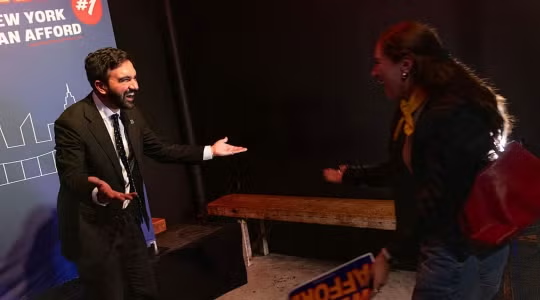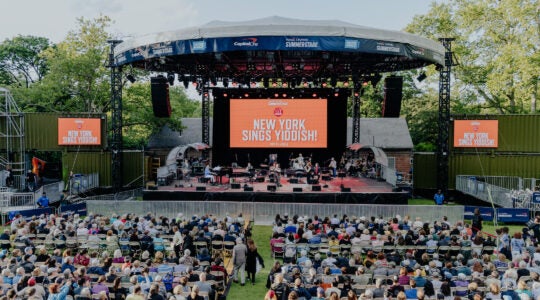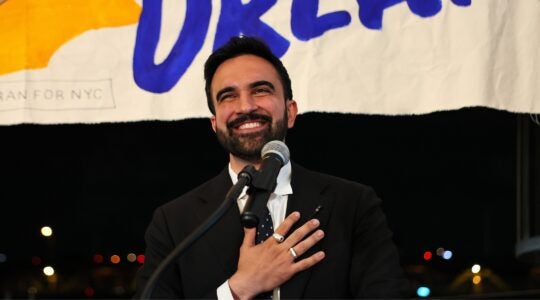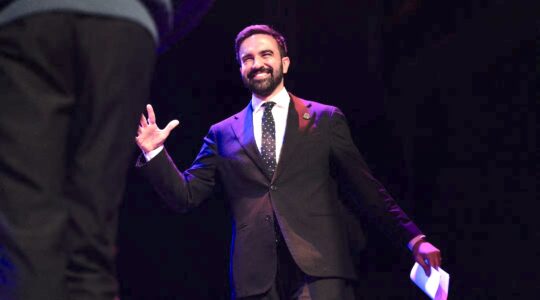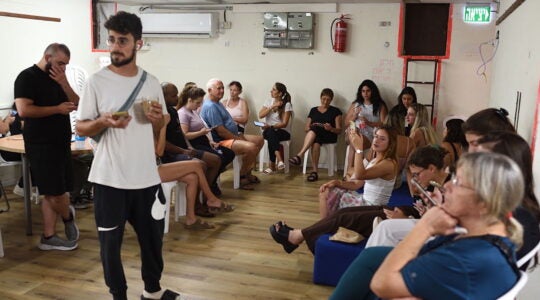There were fears that the already polarized community of Lakewood, N.J. — where an Orthodox influx has roiled tensions with African Americans — would boil over in the wake of a savage beating of an Orthodox rabbi by a black man.
But an organization formed a year ago of representatives of the major ethnic groups in Lakewood is credited with defusing tensions there following the baseball bat beating there last week of Rabbi Mordechai Moskowitz.
The group, the Lakewood Community Response Team, was created at the suggestion of the federal Department of Justice following the arrest of an Orthodox Jewish middle-school teacher on charges of assaulting a black teenager; he was acquitted last summer.
“For the better part of a year, African American, Latino, Orthodox Jews and clergy have been meeting monthly to work on forging and strengthening our relationships for just this sort of an incident,” said Warren Sherard, president of the local chapter of the NAACP. “These meetings really made a difference in how we responded as a community.”
But there is fear in Lakewood because the assailant is still on the loose, according to Ben Heineman, a local printer and father of a 15-year-old daughter.
“I won’t let her go out [at night] now,” he said. “And I told her to be wary during the day when she is out. She understands. … Definitely until this guy is caught going out at night is out of the question, and even after that I want her to make sure she stays in well lit areas with at least two friends.”
Sherard, who at the time of the attack was in Israel on a leadership mission sponsored by the Jewish Council for Public Affairs and the United Jewish Communities, said the Response Team has allowed community leaders to get to know one another and develop “a stronger and deeper respect for each other. It does not mean that everything is perfect and that we have solved all issues, but the meetings have fostered trust and faith in one another, and that is what people are seeing as they hear us react to this tragic incident.”
He was referring to the savage beating of Rabbi Mordechai Moskowitz, 53, as he was walking to synagogue at 8 p.m. on Oct. 9. Rabbi Moskowitz, who has taught third graders for about three decades at the Lakewood Cheder School for Boys, was reportedly struck with a bat by a black man who turned on the rabbi after the two men silently passed each other in the street. The man, said to be in his 30s or 40s, was wearing a dark plaid shirt.
“He was hit six or eight times,” said Rabbi Moshe Zev Weisberg, one of the Response Team leaders. “The injuries could have been fatal. It’s only by the grace of God that he survived. His eye sockets are broken, his nose is broken and his skull is cracked. I heard from seasoned EMTs that the shape they found him in was horrific. People said they have never seen anything like this. … He will have to undergo rehabilitation and extensive plastic surgery.”
Community leaders and the Anti-Defamation League have offered a $25,000 reward for information leading to the arrest and conviction of the assailant.
Lt. Joseph Isnardi, Lakewood’s chief of detectives, said that when the attack occurred “we got calls immediately, and as people started to approach, the assailant ran and dropped the bat.”
Police recovered an aluminum bat at the scene believed used in the attack.
Although there were initial reports that the black man yelled “Jew” each time he struck the rabbi, Isnardi said there were numerous witnesses, none of whom heard any words spoken between the two men. He said he has spoken with Rabbi Moskowitz, whom he described as in stable condition and in “good spirits,” and noted that the rabbi does not remember the attack. Three detectives have been assigned to the case.
“We have no evidence to prove this was a bias crime,” Isnardi added, noting that the assailant could have simply been a deranged man.
The incident comes at a time of continuing transition and roiling tension in Lakewood, a 26-sqare-mile community about 15 minutes from the Jersey shore that is roughly due east of Philadelphia and about an hour south of Manhattan. It is a community of about 75,000 people in Ocean County, about 45,000 of whom are haredi or fervently Orthodox Jews, according to Ray Coles, Lakewood’s mayor for the last three years.
Coles said Hispanics represent about 15 percent of the population, although that figure may be low because there are a large number of illegal immigrants. Blacks, he said, represent about 8 percent of the population, a figure that has been slowly declining.
“This is a changing town,” he said. “There are definitely tensions.”
He said some of that tension comes from the fact that there has been a large influx of haredi Jews in the last 10 or 15 years. They have moved from Brooklyn, Monsey, Baltimore and areas of Mexico into the historically black sections of town, and Coles said some black residents complain they “feel they are being pushed out.”
Blacks are not the only ones who have left. Coles, a Catholic, said his church had 800 members five years ago and only 400 today.
“A lot of them are moving no more than two miles away to larger and more expensive homes” because of the high prices their homes now command, Coles said.
The haredi Jews, in turn, are knocking down the homes they have just bought and building new ones or are expanding the homes they have bought.
Mike McNeil, who is black and director of Solution to End Poverty Soon (STEPS), said his mother is selling her house and getting “more than twice what it was worth” just a few years ago.
“I’m glad because she’ll make a lot of money for her retirement,” he said.
About 15 years ago Lakewood was a “struggling middle class community that could either go up or take a serious downward turn,” Coles recalled. “So in a way, they [the Orthodox Jews] have brought a renaissance to the community. Property values have increased and vacant stores have almost disappeared. But it came at a price. There is almost a different culture now and many people who lived here do not understand it or do not want to, and view it as a threat.”
McNeil said there are some people in Lakewood who “got very rich” when they sold their property.
“Nobody wants to talk about this, but a lot of the minorities owned a lot of land. A lot of them got very wealthy” and moved to the South.
He disputed those who claim they have been pushed out and added: “When the town was down and stores were boarded up, we were lucky if we could sell for $100,000. Some have adapted to the change and some have not. … I’m a black guy and I’m not going to sell to another black guy if I can make another $200,000 [from selling to a haredi Jew]. It is economics that is driving this.”
David Pollock, associate executive director of the Jewish Community Relations Council of New York, noted that haredi Jews first moved to Lakewood in 1943, when the late Rabbi Aaron Kotler moved his yeshiva, Bais Midrash Gevoha, there. He said the yeshiva was an anchor that served as a magnet for many Orthodox groups, including Satmar, Lubavitch, Bobov and other chasidic groups.
Danny Goldberg, executive director of the Jewish Federation of Ocean County, which is based in Lakewood, said he perceived “anxiety” in Lakewood.
“On a communal level there is an atmosphere of anxiety — a sense that something is not right and that people are a little anxious,” he said. “There are two communities here and one feels the other is growing and swallowing the land and it doesn’t know how to respond. There is an immense amount of frustration that has built up. I’m not convinced that this is reflected in tension in people’s lives, but on a communal level there is antagonism between the two communities because they don’t see eye-to-eye on the future of the city.”
The influx of haredi Jews has also prompted both the community’s only Conservative and Reform synagogues to move. Rabbi Lee Paskind, spiritual leader of Congregation Ahavat Shalom, said his Conservative congregation will merge with a congregation five miles to the north in neighboring Monmouth County.
At its peak before the influx of the haredi Jews 10 or 15 years ago, Rabbi Paskind said his 50-year-old congregation had 400 member families; now it has 200.
“We had a large number of seniors,” he said. “Some have died and some have moved away. The new people who are moving in are attracted to the Orthodox community. That is the demographic reality that has made it inevitable that we would be moving.”
The Reform synagogue, Temple Beth Am, did not return two phone calls seeking comment.
Several community leaders in Lakewood repeated the same refrain this week about the senseless attack on Rabbi Moskowitz: “It was an attack on the entire town.”
“All groups in the community have banded together to denounce this and are looking at it as an attack on Lakewood,” said Heineman, the local printer.
He noted that posters with a police sketch of the assailant have been hung up throughout the community. And he said there is talk of starting a civilian community patrol “to work together with the police” to catch the assailant.
Heineman, an Orthodox Jew, said that in addition to the beating incident a year ago there have been other incidents that have resulted in heightened community tensions.
“We had a 20-year-old girl Jewish girl who was kidnapped and raped a year ago,” he said. “The person was caught. And there was once an African-American kid who was run over [by an Orthodox Jew] when he ran into an oncoming car. African Americans staged a march throughout the town,” but it was clearly an accident, he said.
Etzion Neuer, the ADL’s New Jersey regional director, said the community’s emphasis now was on “attempting to not let this incident divide it.”
Walking past a yeshiva where about 50 young boys wearing black yarmulkes played basketball on an outdoor court, Neuer said he has “heard nothing but disgust for this crime and a commitment from blacks and whites, Jews and gentiles to remain unified.”
“It’s very convenient for outsiders to point to the divisiveness of Lakewood and the interracial strife here, but what we are seeing emerging from this incident is a community that demonstrates a willingness to come together in the face of violence,” he added.
The New York Jewish Week brings you the stories behind the headlines, keeping you connected to Jewish life in New York. Help sustain the reporting you trust by donating today.
